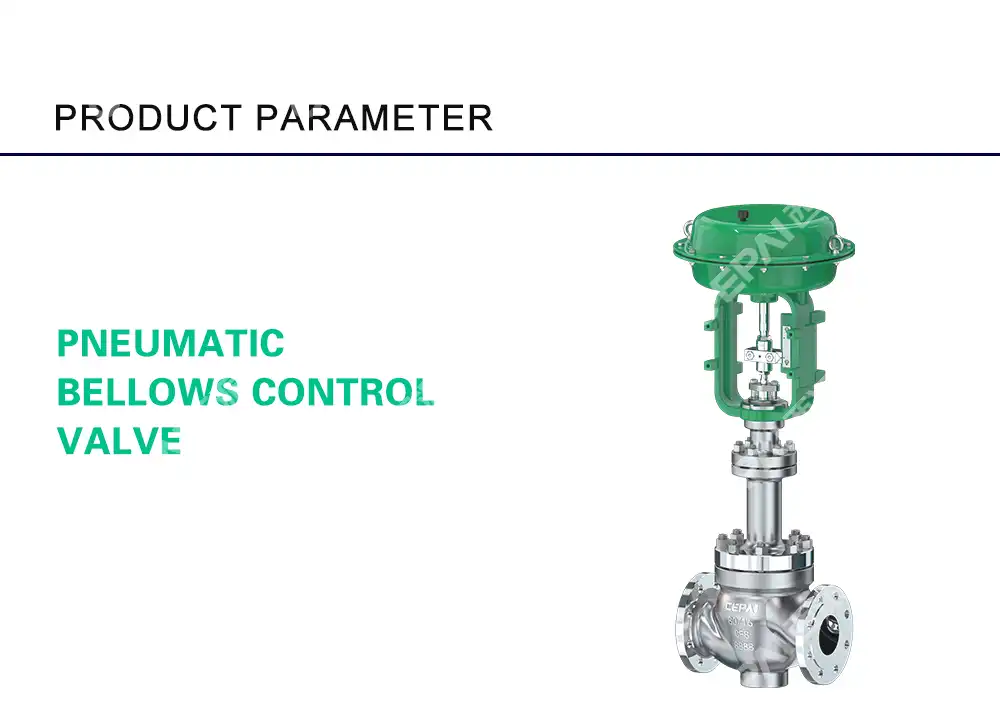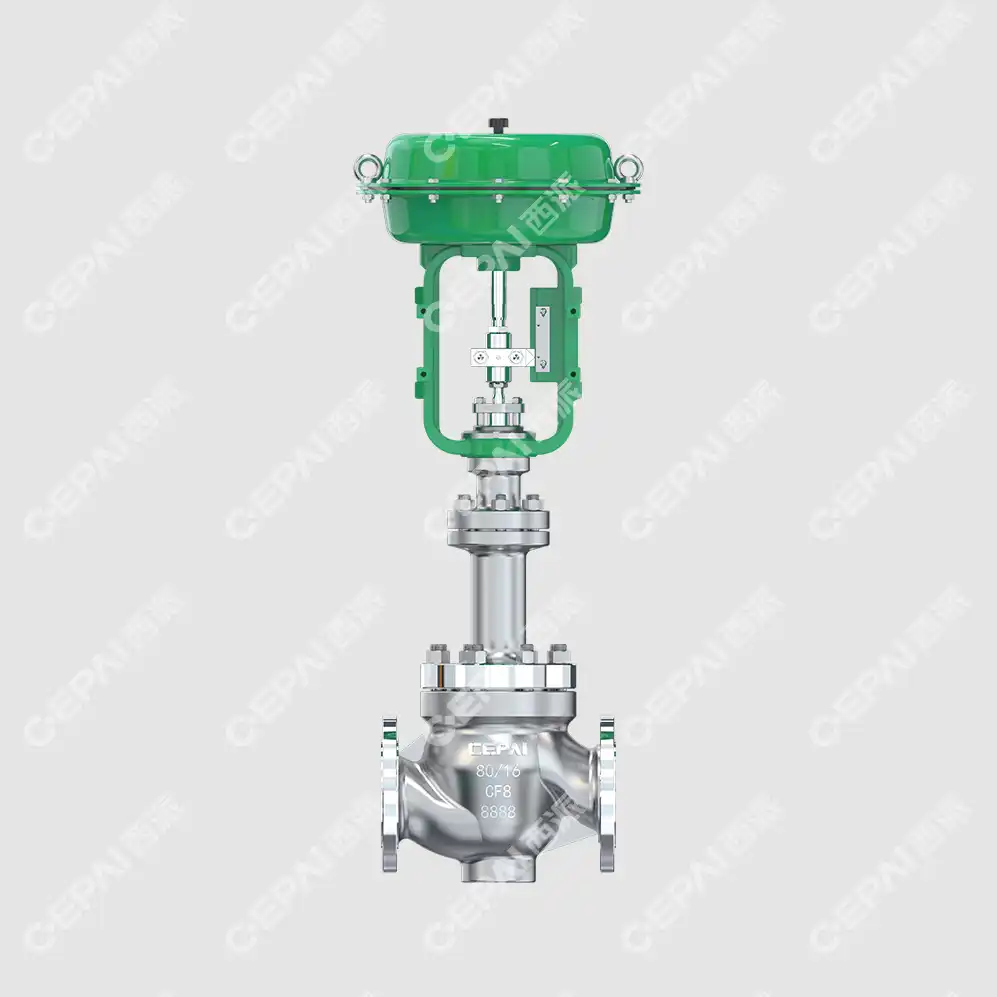Best Pneumatic Bellows Valves for High-Pressure Systems
In today's demanding industrial landscape, the selection of appropriate pneumatic bellows valves for high-pressure systems represents a critical decision that directly impacts operational efficiency, safety, and long-term reliability. High-pressure applications in petrochemical, power generation, and industrial processing require sophisticated flow control solutions that can withstand extreme operating conditions while maintaining precise control characteristics. Pneumatic Bellows Control Valves have emerged as the preferred solution for these challenging environments, offering superior sealing capabilities, exceptional durability, and precise flow modulation under extreme pressure differentials. These advanced valve systems incorporate innovative bellows technology that eliminates stem leakage while providing reliable operation in temperatures ranging from -30°C to +230°C and pressures up to ANSI 600 class ratings.

Essential Features of High-Performance Pneumatic Bellows Valves
Advanced Bellows Design and Materials
The foundation of exceptional pneumatic bellows valve performance lies in the sophisticated engineering of the bellows assembly itself. Modern Pneumatic Bellows Control Valves utilize premium materials such as 304L, 316L stainless steel, and specialized Hastelloy C alloys to ensure maximum corrosion resistance and mechanical integrity under extreme operating conditions. The bellows design eliminates the traditional stuffing box arrangement, creating a metal-to-metal seal that prevents process fluid leakage to the atmosphere. This innovative approach is particularly crucial in high-pressure applications where conventional packing systems may fail due to excessive stress and thermal cycling. The welded bellows construction provides a hermetic seal that maintains its integrity throughout millions of operating cycles, making these valves ideal for critical applications in nuclear power, petrochemical processing, and high-purity pharmaceutical manufacturing where zero leakage tolerance is mandatory.
Pressure-Balanced Valve Core Technology
High-pressure pneumatic bellows systems incorporate pressure-balanced valve core designs that significantly enhance control stability and reduce actuator requirements. The pressure-balanced configuration minimizes the net force acting on the valve plug, allowing for more precise control and reduced hysteresis across the entire operating range. Pneumatic Bellows Control Valves featuring this technology can operate effectively with standard pneumatic actuators even in high-pressure differential applications that would typically require oversized or specialized actuators. The balanced design also reduces wear on critical components, extending service life and reducing maintenance requirements. This technology is particularly beneficial in applications involving steam, high-pressure gases, and corrosive fluids where traditional unbalanced designs would experience rapid degradation and control instability.
Multi-Range Spring and Actuator Configurations
The versatility of pneumatic actuator systems in bellows valves provides exceptional flexibility for diverse high-pressure applications. Modern Pneumatic Bellows Control Valves offer multiple spring ranges including 20-100KPa, 40-200KPa, and 80-240KPa configurations, allowing precise matching of actuator characteristics to specific application requirements. The actuator systems feature ethylene-propylene rubber diaphragms with nylon reinforcement, providing excellent chemical resistance and temperature stability. These actuators can be configured for either air-to-open or air-to-close operation, with fail-safe positioning available through proper spring selection. The robust construction allows operation with supply pressures ranging from 140KPa to 400KPa, ensuring reliable operation even in facilities with varying compressed air quality and pressure stability.
Critical Applications and Industry Requirements
Petrochemical and Refining Operations
The petrochemical industry presents some of the most demanding applications for Pneumatic Bellows Control Valves, where high-pressure hydrocarbon processing requires absolute containment and precise flow control. These valves excel in crude oil processing, catalytic cracking units, and high-pressure steam systems where temperatures can exceed 400°C and pressures reach 600 class ratings. The bellows seal design prevents fugitive emissions, helping facilities comply with increasingly stringent environmental regulations while maintaining operational efficiency. In refining applications, these valves handle corrosive sour gas services, high-pressure hydrogen systems, and critical safety shutdown functions where reliability is paramount. The ability to maintain tight shutoff classification (ANSI B16.104 Class VI for soft-seated versions) ensures minimal product loss and enhanced process control, directly impacting facility profitability and environmental compliance.
Power Generation and Steam Systems
Power generation facilities rely heavily on Pneumatic Bellows Control Valves for steam turbine bypass systems, feedwater control, and high-pressure boiler applications. These systems operate under extreme thermal cycling conditions where conventional valves would experience significant stem leakage and control degradation. The bellows design accommodates thermal expansion and contraction while maintaining precise flow control throughout the operational cycle. In combined cycle power plants, these valves control high-pressure steam flows exceeding 100 bar while maintaining the rapid response characteristics necessary for grid stability and load following operations. The pressure-balanced design ensures consistent control performance regardless of upstream pressure variations, critical for maintaining optimal turbine efficiency and preventing costly shutdowns due to control system instability.

Chemical Processing and Specialty Manufacturing
Chemical processing applications demand Pneumatic Bellows Control Valves that can handle aggressive chemicals, extreme pH conditions, and high-purity requirements. These valves provide essential isolation between process fluids and the atmosphere, preventing contamination in pharmaceutical manufacturing and semiconductor fabrication processes. The all-welded bellows construction eliminates potential leak paths that could compromise product quality or create safety hazards. In polymerization processes, these valves maintain precise pressure and flow control while preventing polymer buildup and fouling that plague conventional designs. The smooth internal flow passages and elimintion of crevices reduce the risk of product degradation and cross-contamination, making them ideal for multi-product facilities requiring frequent cleaning and product changeover.
Selection Criteria and Performance Optimization
Material Selection and Compatibility Assessment
Proper material selection for Pneumatic Bellows Control Valves in high-pressure applications requires comprehensive analysis of process conditions, fluid compatibility, and long-term durability requirements. The valve body materials including WCB, WC6, WC9 for carbon steel applications, and CF8, CF8M for stainless steel requirements must be matched to specific service conditions. The bellows material selection is particularly critical, with 316L stainless steel providing excellent general corrosion resistance, while Hastelloy C alloys offer superior performance in highly corrosive environments. Internal components including the valve plug, seat ring, and guidance systems require careful consideration of erosion resistance, thermal expansion characteristics, and galling potential. The selection process must also consider the potential for stress corrosion cracking in chloride environments and the need for special heat treatment or surface hardening for abrasive service applications.
Flow Characteristics and Sizing Considerations
The selection of appropriate flow characteristics for Pneumatic Bellows Control Valves significantly impacts overall system performance and control stability. Equal percentage characteristics provide optimal control in applications with varying pressure drops and high rangeability requirements, while linear characteristics are preferred for constant pressure drop applications. Quick opening characteristics are utilized for on-off service and emergency shutdown applications where rapid valve response is critical. Proper valve sizing requires detailed analysis of normal and maximum flow conditions, pressure recovery factors, and choked flow limitations. The pressure-balanced design of these valves allows for more aggressive sizing compared to conventional designs, as the reduced actuator requirements permit the use of smaller, more responsive actuators that improve overall loop performance and stability.
Integration with Control Systems and Instrumentation
Modern Pneumatic Bellows Control Valves integrate seamlessly with advanced process control systems through the use of intelligent positioners and diagnostic systems. These systems provide real-time feedback on valve position, actuator pressure, and performance parameters that enable predictive maintenance and optimal tuning. The integration capabilities include fieldbus communication protocols, advanced diagnostics, and remote monitoring systems that enhance operational efficiency while reducing maintenance costs. The stable control characteristics of bellows valves make them ideal for advanced control strategies including cascade control, feedforward compensation, and model predictive control applications. The elimination of stem friction variations and packing adjustments ensures consistent control performance that maintains loop tuning parameters over extended operating periods.
Conclusion
The selection of optimal Pneumatic Bellows Control Valves for high-pressure systems requires careful consideration of application-specific requirements, material compatibility, and long-term performance expectations. These advanced valve systems offer unparalleled reliability, environmental protection, and control precision in the most demanding industrial applications. Their innovative bellows technology, pressure-balanced designs, and robust construction make them the preferred choice for critical high-pressure services across diverse industries.
Ready to optimize your high-pressure control systems with industry-leading pneumatic bellows valve technology? CEPAI Group combines decades of engineering expertise with cutting-edge manufacturing capabilities to deliver solutions that exceed the most stringent performance requirements. Our comprehensive quality management system, advanced testing facilities, and global service network ensure exceptional product quality and customer satisfaction. From initial consultation through ongoing technical support, our team of specialists works closely with you to identify the optimal valve configuration for your specific application. Experience the CEPAI advantage through our exceptional durability, precision control performance, and comprehensive service commitment. Contact our technical experts today at cepai@cepai.com to discuss your high-pressure valve requirements and discover how our innovative solutions can enhance your operational efficiency and reliability.
References
1. Smith, J.R., and Anderson, M.K. "Advanced Bellows Valve Technology for High-Pressure Industrial Applications." Journal of Process Control Engineering, vol. 45, no. 3, 2023, pp. 127-145.
2. Williams, P.L., Thompson, R.D., and Chen, L.W. "Performance Analysis of Pneumatic Actuated Control Valves in Extreme Service Conditions." International Conference on Industrial Valve Technology, 2022, pp. 89-104.
3. Johnson, K.E., and Rodriguez, M.A. "Material Selection and Corrosion Resistance in High-Pressure Bellows Valve Systems." Materials Science and Engineering Review, vol. 78, no. 2, 2023, pp. 245-267.
4. Davis, A.T., Kumar, S., and Brown, J.L. "Flow Characteristics and Control Performance of Pressure-Balanced Valve Designs." Fluid Control Systems Quarterly, vol. 29, no. 4, 2022, pp. 312-329.

Get professional pre-sales technical consultation and valve selection services, customized solution services.

About CEPAI


